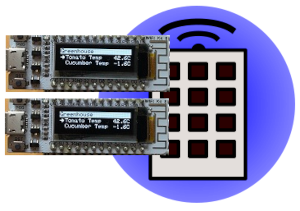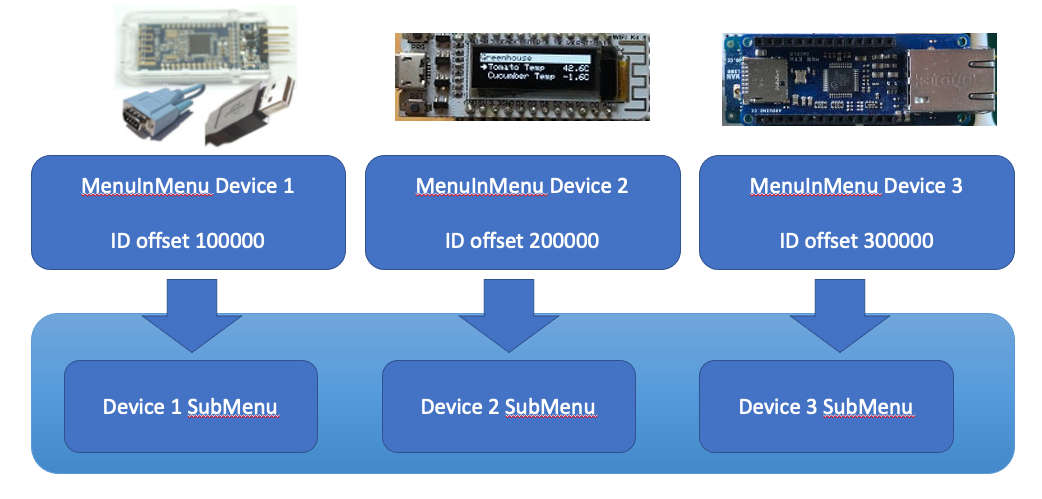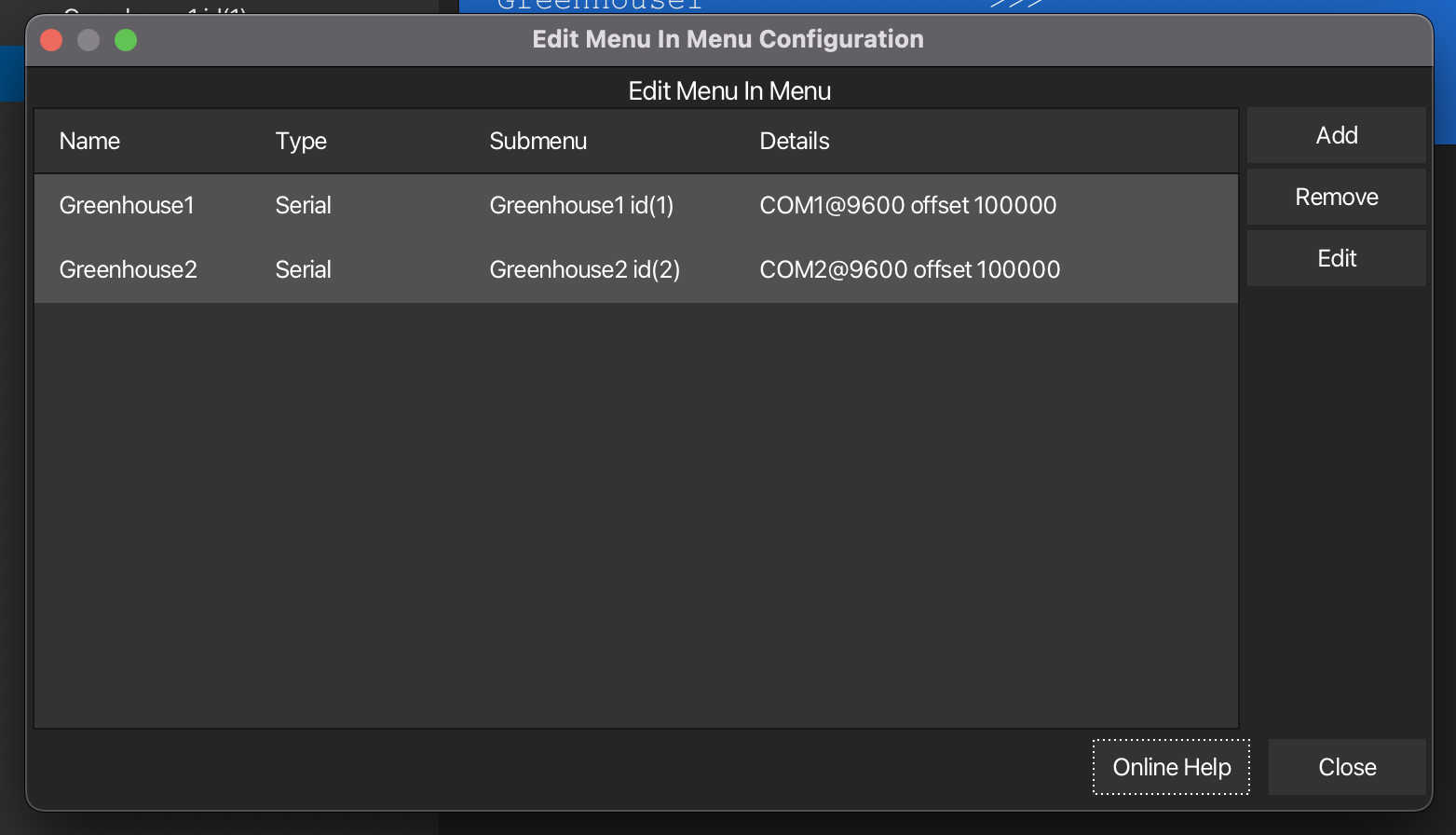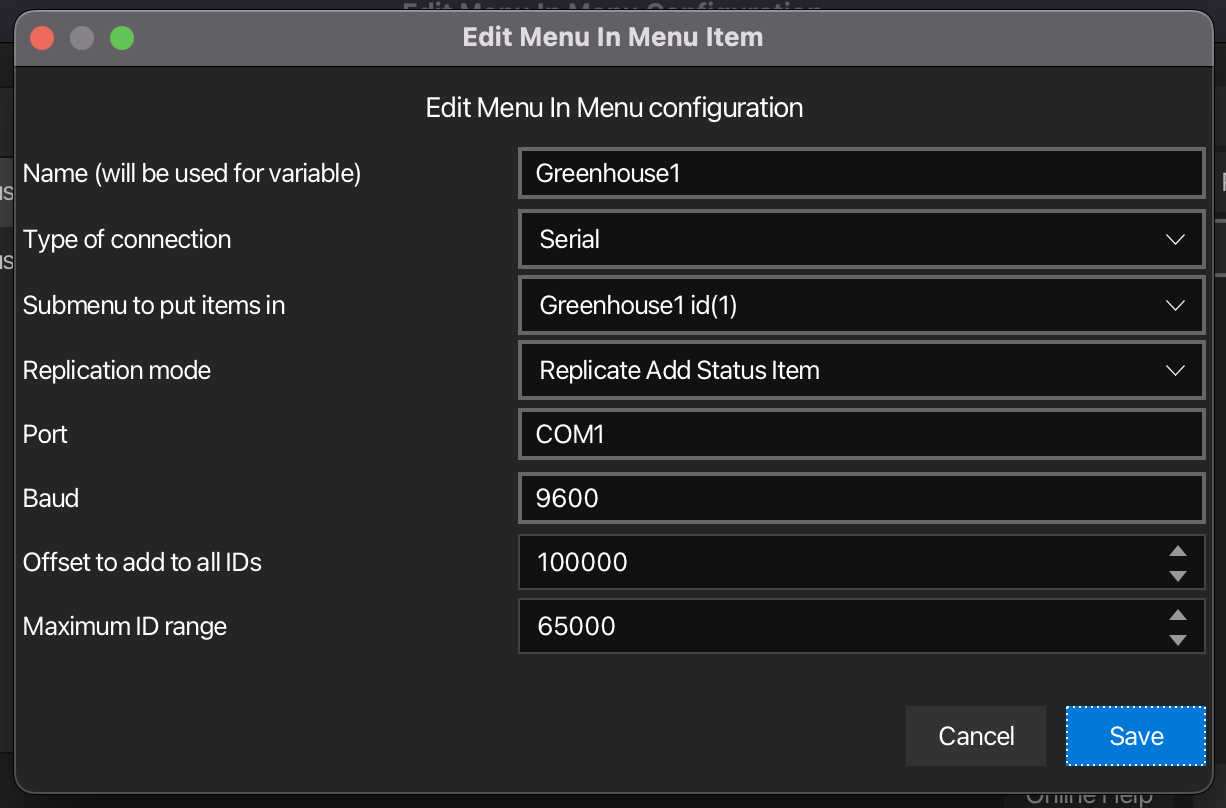
You can combine many menu structures from different devices into a single menu, this works by each remote menu being represented by a MenuInMenu object being associated with a RemoteConnection and a MenuManagerServer. It maps the remote menu into an unused ID range on the local device and even handles dialog commands. Available from version 2.3 of tcMenu Designer and API.
Menu In Menu range and submenu mapping
Each menu in menu definition that we create results in a remote connection to another device, and the selected sub-menu receiving all the menu items from that device as if they were local menus. To ensure there are no ID overlaps, the IDs of the remote menus are given an offset so they appear unique locally. However, should you alter any of these menu items they will be sent remotely with their original ID.
In the diagram below we have three MenuInMenus, Device 1 maps all remote item ID by adding 100000 to them and the items appear in the “Device 1 SubMenu” locally. Device 2 maps all remote item ID by adding 200000 to them and the items appear in the “Device 2 SubMenu” locally, and likewise Device 3 maps all remote item ID by adding 300000 into the “Device 3 SubMenu” locally.

Menu In Menu operation showing ID and submenu mapping
In addition to the range of IDs we also provide the dialog manager that will be used to forward any dialogs from the remote, the submenu in the local tree where this menu should be replicated, and also the replication mode, there are tree possible modes:
REPLICATE_SILENTLY- this does not tell the manager that the tree has structurally changed, useful only in certain circumstances.REPLICATE_NOTIFY- this mode notifies of any structural changesREPLICATE_ADD_STATUS_ITEM- this mode notifies and also creates a boolean menu item representing the state of the connection.
Creating MenuInMenu connections
If you’ve not already read it first read the Embedded Java core documentation
Notes about pairing
You must ensure that the UUID you have chosen is paired with the device as the MenuInMenu system has no means of pairing. Choices are:
- Do not use any authentication.
- Use read only authentication method that is pre-populated with the UUID and name.
- Use the EEPROM authentication but ensure you have already paired with that UUID and name.
Adding Menu in Menu support via Designer
MenuInMenu is a first class concept in the designer UI. To edit connections:
First ensure that you have the platform set to “RaspberryPI / Java”. This is the only platform to support menu in menu.
From the “Code” menu select the “Menu In Menu” option, this will present the menu in menu editor shown below:

Menu In Menu selection window
In the above window the table shows the list of currently set up MenuInMenu items for this project. Here you can “Add”, “Edit” and “Remove” items. When you add or edit an item the following dialog appears:

Menu In Menu item editor
In the above dialog the fields are as follows:
- Name is the name of this item, it will be used as a variable name by removing white space from it.
- Type of connection can either be Socket to create a network connection, or Serial to create any type of Serial connection.
- SubMenu to put items in is the place where all the items will appear from the remote menu.
- Replication mode is described earlier in this page
- Offset to add is the amount to add to all incoming IDs to ensure they are unique
- Maximum ID Range is the amount of IDs needed for this remote menu
For Socket connections
- IP Address / Hostname is the address of the remote device
- Port is the port of which the remote device is listening
For Serial connections
- Port is the name of the port to connect to
- Baud is the baud rate to start the connection at
How code generator generates these items
Once created, these items will appear in the “App” class in their own method.
Adding Menu in Menu support manually
Although you can add MenuInMenu items manually, it is far easier to add them using designer UI, however the basic procedure for manual creation is:
- Ensure you have access to the
MenuManagerServerandDialogManagerinstances. - Create a RemoteServerConnection to the device you want to connect to, for example over RS232 or Socket.
- Create a MenuInMenu instance based on the above parameters.
- Start the MenuInMenu instance.
Once started, this will keep the menu from the remote up to date in our local menu. Any changes made to it will be reflected back to the device. This is very useful when combined with embedCONTROL, as the PI can serve up a single web application with the data from all your devices.
Other pages within this category
- Menu library remote connectivity tutorial
- Menu In Menu support for embedded Java on Linux / Raspberry PI
- Control menus with embedCONTROL.JS from a webserver
- Embedded Java ethernet, WiFi and Serial plugin
- SimHub connector for tcMenu library
- ESP8266 / ESP32 WiFi remote plug-in for tcMenu library
- Ethernet2, UipEthernet, Stm32Ethernet remote plug-in for tcMenu library
- Serial remote plug-in for tcMenu library
- tcMenu - Java API to Arduino for remote menu control

